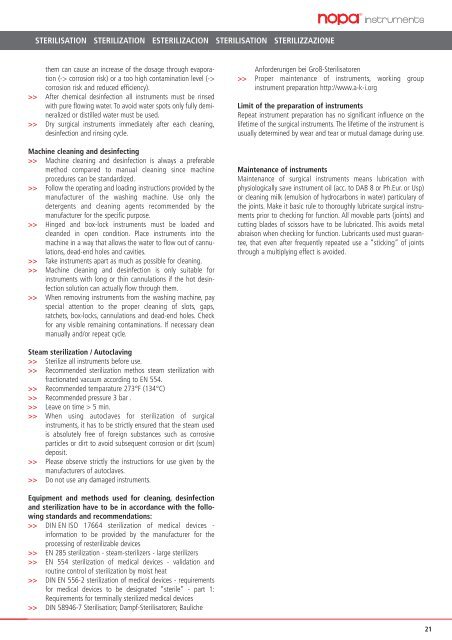Download - nopa instruments
Download - nopa instruments
Download - nopa instruments
Sie wollen auch ein ePaper? Erhöhen Sie die Reichweite Ihrer Titel.
YUMPU macht aus Druck-PDFs automatisch weboptimierte ePaper, die Google liebt.
STERILISATION STERILIZATION ESTERILIZACION STERILISATION STERILIZZAZIONE<br />
them can cause an increase of the dosage through evaporation<br />
(-> corrosion risk) or a too high contamination level (-><br />
corrosion risk and reduced efficiency).<br />
>> After chemical desinfection all <strong>instruments</strong> must be rinsed<br />
with pure flowing water. To avoid water spots only fully demineralized<br />
or distilled water must be used.<br />
>> Dry surgical <strong>instruments</strong> immediately after each cleaning,<br />
desinfection and rinsing cycle.<br />
Machine cleaning and desinfecting<br />
>> Machine cleaning and desinfection is always a preferable<br />
method compared to manual cleaning since machine<br />
procedures can be standardized.<br />
>> Follow the operating and loading instructions provided by the<br />
manufacturer of the washing machine. Use only the<br />
detergents and cleaning agents recommended by the<br />
manufacturer for the specific purpose.<br />
>> Hinged and box-lock <strong>instruments</strong> must be loaded and<br />
cleanded in open condition. Place <strong>instruments</strong> into the<br />
machine in a way that allows the water to flow out of cannulations,<br />
dead-end holes and cavities.<br />
>> Take <strong>instruments</strong> apart as much as possible for cleaning.<br />
>> Machine cleaning and desinfection is only suitable for<br />
<strong>instruments</strong> with long or thin cannulations if the hot desinfection<br />
solution can actually flow through them.<br />
>> When removing <strong>instruments</strong> from the washing machine, pay<br />
special attention to the proper cleaning of slots, gaps,<br />
ratchets, box-locks, cannulations and dead-end holes. Check<br />
for any visible remaining contaminations. If necessary clean<br />
manually and/or repeat cycle.<br />
Anforderungen bei Groß-Sterilisatoren<br />
>> Proper maintenance of <strong>instruments</strong>, working group<br />
instrument preparation http://www.a-k-i.org<br />
Limit of the preparation of <strong>instruments</strong><br />
Repeat instrument preparation has no significant influence on the<br />
lifetime of the surgical <strong>instruments</strong>. The lifetime of the instrument is<br />
usually determined by wear and tear or mutual damage during use.<br />
Maintenance of <strong>instruments</strong><br />
Maintenance of surgical <strong>instruments</strong> means lubrication with<br />
physiologically save instrument oil (acc. to DAB 8 or Ph.Eur. or Usp)<br />
or cleaning milk (emulsion of hydrocarbons in water) particulary of<br />
the joints. Make it basic rule to thoroughly lubricate surgical <strong>instruments</strong><br />
prior to checking for function. All movable parts (joints) and<br />
cutting blades of scissors have to be lubricated. This avoids metal<br />
abraison when checking for function. Lubricants used must guarantee,<br />
that even after frequently repeated use a “sticking” of joints<br />
through a multiplying effect is avoided.<br />
Steam sterilization / Autoclaving<br />
>> Sterilize all <strong>instruments</strong> before use.<br />
>> Recommended sterilization methos steam sterilization with<br />
fractionated vacuum according to EN 554.<br />
>> Recommended temparature 273°F (134°C)<br />
>> Recommended pressure 3 bar .<br />
>> Leave on time > 5 min.<br />
>> When using autoclaves for sterilization of surgical<br />
<strong>instruments</strong>, it has to be strictly ensured that the steam used<br />
is absolutely free of foreign substances such as corrosive<br />
particles or dirt to avoid subsequent corrosion or dirt (scum)<br />
deposit.<br />
>> Please observe strictly the instructions for use given by the<br />
manufacturers of autoclaves.<br />
>> Do not use any damaged <strong>instruments</strong>.<br />
Equipment and methods used for cleaning, desinfection<br />
and sterilization have to be in accordance with the following<br />
standards and recommendations:<br />
>> DIN EN ISO 17664 sterilization of medical devices -<br />
information to be provided by the manufacturer for the<br />
processing of resterilizable devices<br />
>> EN 285 sterilization - steam-sterilizers - large sterilizers<br />
>> EN 554 sterilization of medical devices - validation and<br />
routine control of sterilization by moist heat<br />
>> DIN EN 556-2 sterilization of medical devices - requirements<br />
for medical devices to be designated “sterile” - part 1:<br />
Requirements for terminally sterilized medical devices<br />
>> DIN 58946-7 Sterilisation; Dampf-Sterilisatoren; Bauliche<br />
21



